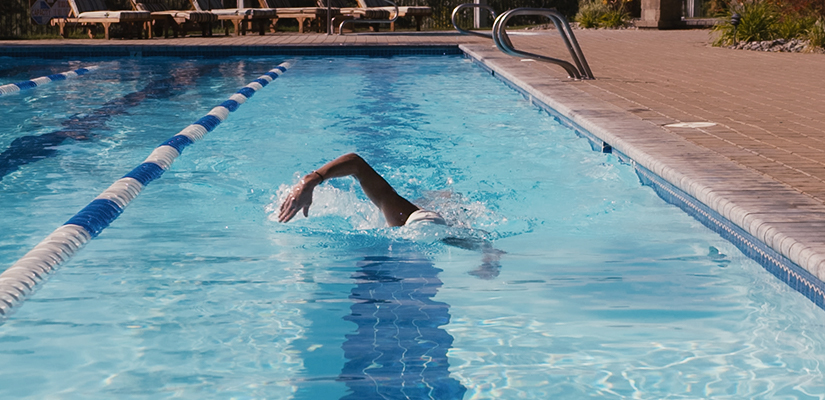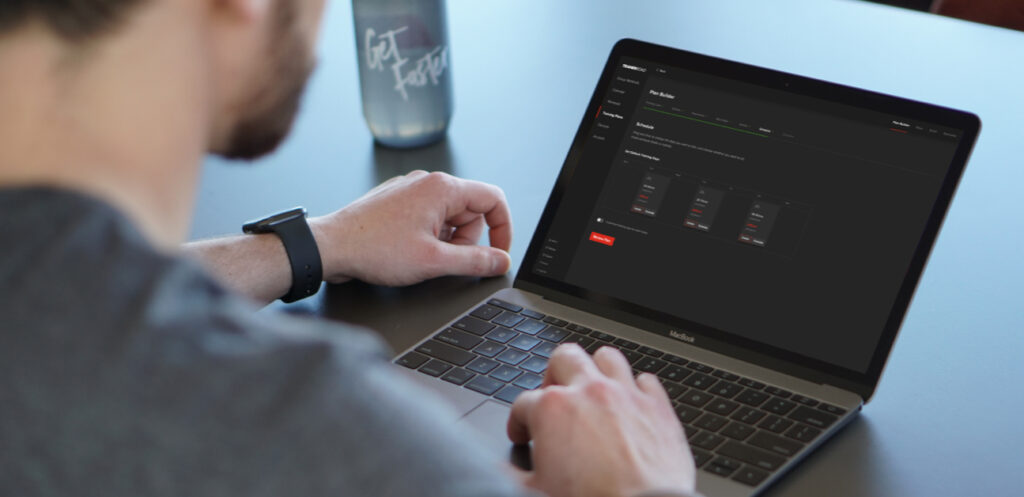Olympic Triathlon Training Plans: How to Choose Your Best Plan

Whether you are simply inspired by the Olympic-distance format or making the upward leap from a Sprint Triathlon, longer distances require a bit more training than the latter to help develop your threshold power across three disciplines. Sounds challenging? It is — but that just means choosing the right training plan is even more critical to your success.
In this new series of posts, my goal is simple: to help every type of triathlete and cyclist discover their best training plan. Today’s post is dedicated to those preparing for an Olympic-distance triathlon.
By the time you hit the bottom of this page, you’ll know the specific training plans we recommend for your tri event, the most important questions to ask yourself before choosing your Olympic-distance triathlon plan and the reasons we recommend them. Let’s get to it, shall we?
Questions to Ask Before Choosing Your Olympic Triathlon Training Plan
Olympic triathlons, which include a .93 mile swim, 24.8 mile bike and 6.2 mile run, more so than the previously discussed sprint triathlons, call for a pickup in training volume and a reduction in intensity. To accommodate these changes, I recommend our Olympic Triathlon Base, Olympic Triathlon Build and Olympic Distance Triathlon plans to prepare for your Olympic-distance triathlon.

Before I get into the details of these specific training plans and the reasons they’re effective, it’s important for triathletes to first reflect on the following three questions:
Have I completed a triathlon recently?
Many triathletes preparing for an Olympic triathlon structure their season so that the date of their international-distance event falls on the heels of completing a sprint triathlon. If this sounds like you — meaning you’ve trained for and finished a sprint triathlon within the last 30 days (2 weeks is when your strength and aerobic gains start to slip but 30 days means they’ll have dwindled significantly) — then you’re in a good position to bypass your base conditioning and jump straight into Build and Speciality.
If you have not recently trained for and completed a sprint triathlon with the last 30 days, ask yourself if you’re absolutely certain you want to attempt an Olympic distance. Athletes who have a somewhat strong background in endurance sports or training in general should be fine, but those who do not might be better off preparing for a sprint triathlon first. If you’re 100% adamant about training for an international-distance triathlon to kick off your triathlon career, then you must go into your experience expecting a higher training burden.
How many times a day do I have available to train?
Time: it’s one of the greatest limiters part-time athletes face. Knowing how much of it you can devote to training not only each week, but each day, will help you decide which volume of training plan is best for you. Here are some simple guidelines to follow:
• If you can train once a day, covering one discipline twice per week, you’re going to want to choose a low-volume plan.
• If you have can train twice per day, covering one discipline 3-4 times a week, a mid-volume plan is probably a good fit.
• If you have can train twice per day, covering one discipline 5-6 times a week, you might be okay choosing a high-volume plan.
What’s the finish time I’m shooting for?
The type of goal you have determines the degree of commitment and sacrifice that will be required of you. It makes perfect sense. If you have big goals, like, say, to win your Age Group, then you have to be ready to put in the time and hard work. Now that’s all fine and dandy, but where some athletes misstep is they forget to consider how much stress their body can realistically manage throughout their event’s training. If you’re coming from a place of little triathlon experience and less-than-desirable fitness capabilities, these facts should not deter you. Rather, they should be used to help guide you in the most appropriate direction.
Here’s one misconception I really want to clarify: Choosing a high-volume plan does not mean you’re more serious about your training than an athlete who chooses to use a mid- or low-volume training plan. It simply means each athlete wisely selected the plan they thought best supports their goals and, most importantly, respects their training background and experience.
For first-time Olympic-distance triathletes who don’t have a previous race time to compare, it can be helpful to know some rough times to shoot for. Keeping a beginner triathlete’s typical amount of experience in mind, I’ve suggested plan volumes for each finish-time goal.
• 3:00 finish time — this is a modest finish time for beginner triathletes who simply want to finish their event. If achieving a lower-end finish time isn’t as important to you as simply feeling strong enough to finish the event, you can feel confident choosing a low-volume plan.
• 2:40 finish time — this is the average finish time for an Olympic-distance event. If this is your aim, consider selecting a mid-volume training plan.
• Under a 2:40 finish time — firstly, know that elite-level triathletes commonly complete this event in under 2 hours. Keeping that benchmark in mind, if you’re setting an extremely ambitious finishing-time goal for yourself, a high-volume training plan may or may not be right for you. If — and only if — you’re a beginner triathlete who has an established foundation of fitness, whether that be in endurance sports or not, will a high-volume plan be appropriate.
Choosing the training plan volume that’s right for you is 25% what your goals are, 25% how much time you have available to train and 50% how well your body can manage and recover from stress. This illustrates an important point: you can have lofty goals and a lot of time to train, but if your body is not accustomed to sustaining high levels of training stress, then you’re almost always better off opting for a lower volume plan.
The Plans We Recommend to Prepare for a Olympic Triathlon
As I mentioned above, the specific training plans we suggest for those looking to prepare for a Olympic triathlon are our Olympic Triathlon Base, Olympic Triathlon Build and Olympic Distance Triathlon plans. Take a look at the details of the three plan volumes we offer below:
Olympic Triathlon Plans
Olympic Base
Low Volume
- 6 weeks
- Swim: 46-61 Min/Wk
- Bike: 126-152 TSS/Wk
- Run: 70-105 Min/Wk
Mid Volume
- 6 weeks
- Swim: 92-116 Min/Wk
- Bike: 154-208 TSS/Wk
- Run: 125-175 Min/Wk
High Volume
- 6 weeks
- Swim: 161-191 Min/Wk
- Bike: 231-359 TSS/Wk
- Run: 155-195 Min/Wk
Olympic Build
Low Volume
- 6 weeks
- Swim: 53-72 Min/Wk
- Bike: 157-312 TSS/Wk
- Run: 70-125 Min/Wk
Mid Volume
- 6 weeks
- Swim: 113-152 Min/Wk
- Bike: 251-314 TSS/Wk
- Run: 125-175 Min/Wk
High Volume
- 6 weeks
- Swim: 192-236 Min/Wk
- Bike: 304-376 TSS/Wk
- Run: 150-235 Min/Wk
Olympic Specialty
Low Volume
- 8 weeks
- Swim: 54-79 Min/Wk
- Bike: 80-202 TSS/Wk
- Run: 55-140 Min/Wk
Mid Volume
- 8 weeks
- Swim: 66-164 Min/Wk
- Bike: 134-334 TSS/Wk
- Run: 85-200 Min/Wk
High Volume
- 8 weeks
- Swim: 125-256 Min/Wk
- Bike: 194-431 TSS/Wk
- Run: 116-260 Min/Wk
Each of our new triathlon training plans come with detailed swim, bike and run workouts that go well beyond the all-too-familiar bulleted list. With these updated plans you’ll get weekly objectives, training tips and coaching insights from me scattered throughout each phase of training.
Why We Recommend These Plans for Olympic Triathletes
There are many reasons we recommend the Olympic triathlon plans we do. You might notice that the same reasons we mention in our sprint triathlon plans post are relevant to our Olympic triathlon plans. Sticking to that rational, we’ve decided to insert them once more here.
20 Weeks of Progressive Training
As with every training plan we provide, our Olympic triathlon plans are progressively phased to help you cultivate a solid foundation of fitness, build your muscular endurance and fine-tune your training for your specific event. To prepare for your Olympic-distance event, you’ll get 6 weeks of Base, 6 weeks of Build and 8 weeks of Specialty for a total of 20 weeks of training.
3 Volumes of Training Plans to Choose From
At this point, I’ve already briefed you quite a lot on how to choose the training plan volume that’s right for you. Now is when I take a moment to explain why every one of our new triathlon training plans has a Low-, Medium- and High-Volume plan option. Without getting too in the weeds (there’s always another time for that), we do this so that every athlete, no matter what their personal fitness level is, can find a plan that’s manageable yet challenging enough to see big results.
High Intensity Throughout All Phases of Training
We often get questions from athletes who are surprised to see we include high-intensity work in Base training. This is absolutely intentional. The goal is help you elevate your muscular strength as quickly and efficiently as possible. By increasing your work capacity early on through short, hard efforts your body will adapt wisely and prepare itself for the more intense training that’s ahead.
Brick Workouts Throughout All Phases of Training
Our Olympic triathlon training plans, like our Sprint Triathlon plans, include brick workouts as early as week two in the Base phase. If you haven’t done a triathlon before, you’ll soon discover what that somewhat strange and heavy feeling in your legs is like the moment you stop biking and start running — your muscles aren’t used to firing like that! This is a feeling to be learned early on. For that reason, I’ve included a lot of confidence-building brick workouts from the get-go, so 20 weeks later your body and mind will be prepared for your event’s transitions.
Power-Based Bike Workouts
All our triathlon training plans include structured bike workouts that are scaled to your fitness when used with the TrainerRoad app. In addition to scaled bike workouts, you’ll also benefit from Workout Text. Workout Text is instructions written by me and displayed on your device’s screen during your bike workouts. The text is there to guide you up until the very last minute of the majority of your 60- to 90-minute bike workouts prescribed in our Olympic triathlon plans.
Clear Objectives For Every Workout
A lot of templated training plans you can find online look like a bulleted list of workouts — no further explanation. You can expect quite the opposite with TR triathlon training plans. Notes like, “Think of a light, fluid stride and walk briefly if you find yourself lumbering or shuffling due to too-high fatigue …,” and explanations like, “The greatest benefit of VO2max works comes with longer durations at that high aerobic uptake …,” are scattered throughout every stage of your training. For first-time and more experienced triathletes, we’ve learned through athlete feedback that these bits of factual and anecdotal insights make all the difference.
Are you ready to start training for a triathlon? With our monthly or discounted annual memberships, you can use TrainerRoad and any of our 80+ properly structured training plans to get ready for your next big event.
